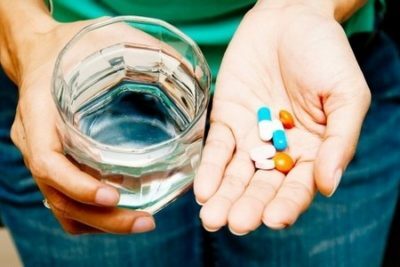1 Causes of the phenomenon
Diarrhea, in which the feces contain foam, appears as a result of the following pathological processes in the body:
- Intestinal infections caused by the penetration of bacteria( salmonella, cholera vibrio, clostridia), viruses( rotavirus, enterovirus, etc.).Foamy liquid stools with similar pathologies are accompanied by an increase in body temperature, general weakness, pain and rumbling in the abdomen, nausea and vomiting. Spontaneously such infections do not pass, timely treatment will prevent irreversible consequences.
- Failure in the ratio of useful and conditionally pathogenic intestinal microflora - dysbiosis. In the intestine of an adult and a child, there are always useful microorganisms( lactobacilli, bifidobacteria, bacteroides, E. coli, yeast-like fungi) and opportunistic pathogens( Staphylococci, Clostridia, Pseudomonas aeruginosa, Proteus, etc.).The ratio of these microorganisms: 99% useful and 1% conditional-pathogenic. If due to antibiotic therapy, decrease of immunity, diseases of the digestive organs, the number of the latter grows, then intoxication and diarrhea begin in the body.
- Allergic reactions. The use of certain products( eggs, peanuts, milk, citrus, gluten, cereals, fish, seafood, etc.), taking medicines( antibiotics, vitamins, etc.) can cause an allergic reaction, which produces a foamy stool and rash.
- Lactase insufficiency. Lactose is milk sugar, which breaks down the enzyme lactase. Very often, infants who are breastfed, do not have enough lactase for the volume of milk that enters the body. The explanation for this is still not fully established functionality of the enzymatic and digestive system in young children. Proceeding from this, a foamy stool in a child in the first months of life is considered the norm, if not accompanied by intoxication. Diarrhea due to dairy products can be not only in children, but also in adults with a hereditary predisposition to lactase deficiency or with diseases of the pancreas( it is responsible for the secretion of the enzyme lactase).
2 Additional factors
In addition to the above reasons, it can provoke frothy feces:
- Fermentation dyspepsia. A number of products( milk, muffins, sweets, fatty foods) is an ideal food for a conditionally pathogenic microflora, which strongly activates fermentation accompanied by a foamy stool. Excessive fermentation can occur in infants due to improper breastfeeding.
- Glistnye( enterobiosis, ascariasis, etc.) and other parasitic infestations( giardiasis, strongyloidiasis, etc.) can be accompanied by constipation and foamy diarrhea. Such symptoms occur when parasites are in the body for a long time.
- Inflammation in the digestive system. Such diseases as peptic ulcer of the stomach and intestines, enterocolitis, duodenitis in the beginning of their development provoke frothy diarrhea. Often this symptom is not perceived as something serious, and then the pathology passes into a chronic form, in which a foamy chair no longer exists.
- Gluten intolerance or celiac disease. Gluten or gluten is a protein that is part of most cereals( wheat, barley, rye, etc.).Such cereals as rice, buckwheat, peas do not contain this protein. Gluten is broken down by enzymes of gastric juice, as a result of which peptides are formed, normally not dangerous for humans. In a child or adult suffering from celiac disease, gluten split into peptides is perceived as a foreign agent, which provokes inflammation in the gastrointestinal mucosa, which is accompanied by a foamy stool and other dyspeptic disorders.
-
 Gastroenterologist. VAZHENOV: "I beg you, if you began to worry about abdominal pain, heartburn, nausea, do not in any way do gases. .."Read more & gt; & gt;
Gastroenterologist. VAZHENOV: "I beg you, if you began to worry about abdominal pain, heartburn, nausea, do not in any way do gases. .."Read more & gt; & gt;

Recommended to read
- Causes of black stool in an adult
- Signs of celiac disease in children
- What does green feces have in a babe
- Effective agent for gastritis and gastric ulcer
3 How to treat a pathology?
Before you treat the problem, you need to identify the cause that caused it. Foamy stools that appear after taking a stale product can be cured by taking absorbents: Activated Carbon, Smecta, Polysorb and the like. To accelerate the process of cleansing the body of poisonous substances of stale products, you should consume more liquid.
Foamy diarrhea in newborns due to improper feeding is also easily prevented. It is enough to know that breast milk is divided into the front, in which more water and lactose, it comes out at the beginning of feeding, with this milk water balance in the child is restored, and the back one, in which there is more fat, fat-soluble enzymes, growth factors, satiety and sleep. Therefore, when feeding, the child should receive both types of milk, which will provide an alternate attachment to the left and right chest.
ADVICE FROM THE MAIN GASTROENTEROLOGIST
Korotov SV: "I can recommend only one remedy for the rapid treatment of Ulcer and Gastritis, which is now recommended by the Ministry of Health. .." Read testimonials & gt; & gt;
If the infant receives artificial feeding - a mixture, then you need to select them strictly individually. With lactase deficiency, the child should receive low-lactose or lactose-free mixtures, with a tendency to ferment dyspepsia - fermented milk mixtures, etc. 
Foam stools resulting from allergies to food or medications are eliminated by establishing the nature of the allergen and excluding interaction with it. At first, immediately after an allergic reaction, the intake of antihistamines will be effective.
With intestinal infections, the stool becomes not only frothy, but also acquires a greenish shade. To develop an effective treatment regimen, it is necessary to conduct a stool analysis to determine the type of causative agent of the infection. If poisoning is caused by viruses, then antiviral drugs are prescribed if bacteria are antibiotics. The treatment complex also includes antipyretics, rehydration therapy( still mineral water, fruit drinks, compotes, teas, freshly squeezed juices, etc.), nutrition is light, rich in vitamins and protein. In intestinal infections, the balance of the intestinal microflora is disturbed. To restore this balance, probiotics and absorbents are used: Lineks, Bifidumbacterin, Probifor, etc.
For celiac disease, a gluten-free diet is prescribed: avoid eating rye bread, pasta, baking from wheat, barley flour, etc. With continuous diarrhea, antidiarrheal drugs are prescribed( Loperamide, Imodium and others).
If diarrhea is caused by parasitic invasions, complex and stage-by-stage treatment is needed. Initially, the intake of absorbents, enzymatic preparations( Creon, Microzyme), choleretics( Allahol, Flamin, etc.) for normal production of bile, multivitamins is prescribed. Further, deworming is performed, i.e.taking drugs that destroy helminths or parasites( Vormil, Vermitin, etc.).The final stage of treatment is restorative therapy - taking pre- and probiotics( Linex, Bifidumbacterin, Dufalac, Hilak forte, etc.).
Changing the stool is an important indicator that there are some abnormalities in the body. This is an excuse for going to the doctor.
- 1 Reasons for the phenomenon
- 2 Additional factors
- 3 How to treat pathology?
Foamy diarrhea is a frequent secretion of liquid feces with an admixture of foam. The liquid stool is called diarrhea in people, in medicine, this condition is referred to as "diarrhea"( from Greek to "flow through or through, leak").Gastrointestinal tract - a very sensitive system of the human body. Eating stale, fatty foods almost always provokes diarrhea. Only diarrhea for this reason often lasts for a short time and spontaneously stops( exception - severe infectious poisoning).Liquid feces with foam - a serious symptom that can occur with a number of pathological changes in the body of an adult or child.
Do you have gastritis?
GALINA SAVINA: "How easy is it to cure gastritis at home for 1 month. A proven method is to write down a recipe. ..!"Read more & gt; & gt;



